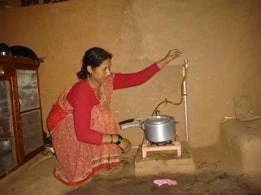 Early this year, I visited several households in the small village of Bela located in the Kavre district of Nepal, about 50 kilometers from the capital Kathmandu. Mr. Niranjan Sapkota’s house was located on a steep mountain surrounded by forests. I had to walk along narrow mountain paths, grabbing on to bushes and sometimes hands of accompanying local staff. I was going to verify if the biogas plant Mr. Sapkota had constructed in the February of 2005 was still in operation. I turned the brass valve in the kitchen and with a hissing sound, gas flowed and the family pointed to the meal that they had just cooked using biogas from cattle dung that they had in plenty.
Early this year, I visited several households in the small village of Bela located in the Kavre district of Nepal, about 50 kilometers from the capital Kathmandu. Mr. Niranjan Sapkota’s house was located on a steep mountain surrounded by forests. I had to walk along narrow mountain paths, grabbing on to bushes and sometimes hands of accompanying local staff. I was going to verify if the biogas plant Mr. Sapkota had constructed in the February of 2005 was still in operation. I turned the brass valve in the kitchen and with a hissing sound, gas flowed and the family pointed to the meal that they had just cooked using biogas from cattle dung that they had in plenty.
There are 225,000 such families in Nepal who now have easy-to-operate biogas plants in their backyards. Bela is considered a model biogas village with almost every house equipped with a biogas plant.
Last month, the Nepal’s Biogas Program reached an important milestone: the United Nations Framework Convention on Climate Change (UNFCCC), for the first time approved and issued carbon credits to two Nepalese biogas projects. To date, this is the largest worldwide issuance of carbon credits, or Certified Emission Reductions (CERs), in a Least Developed Country (LDC). Two more similar projects from Nepal are now at an advanced stage of being registered with the UNFCCC. Together, these projects are expected to generate about 170,000 carbon credits per year, which is equivalent to avoiding emissions from approximately 60,000 cars every year.
For most women living in this mountainous region of Nepal, looking for firewood every morning was a daily ritual. This program reduces the time spent collecting firewood and, since they are no longer exposed to the indoor smoke from burning of firewood in traditional stoves, it also dramatically improves the health of these women and their children. Other important benefits of the program are lessening the pressure on deforestation and reducing greenhouse gas emissions.

For the last several years I have been working with this biogas program. The road to getting carbon credits for the program has not been easy. It has taken over four years to get the first batch of CERs successfully verified and certified through the UN system. The challenges included finding appropriate and credible ways to monitor and quantify carbon credits from thousands of biogas plants that are spread over long distances and located in remote areas.
The deadlock was cleared this past August when the UNFCCC issued the first CERs for the projects. By September 2011, over 92,000 CERs have been issued to the first two registered projects. These carbon credits are helping to offset the cost of owning and operating the plants and making the projects financially sustainable over time. In our evaluation, we found that more than 95% of the biogas plants were operating smoothly after five years of installation, demonstrating the robustness of the technology as well as the quality of program design and implementation. The monitoring system developed in collaboration with the World Bank also works well. Hopefully, this can provide a model for similar projects in other countries, especially in sub-Saharan Africa where firewood is still widely used for cooking.
Seeing the women of Bela in their homes, spending time with their children instead of scouring the countryside for firewood, made this long road to certifying and verifying emissions completely worth the effort.


Join the Conversation